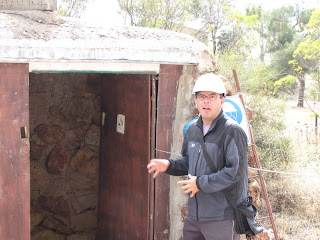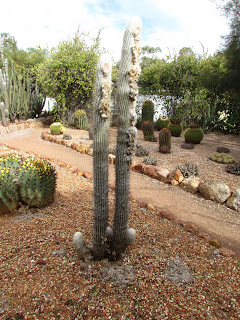Sharon likes to get out of town for a bit every few weeks. I can't understand why. Moree is such an interesting place, but she gets antsy after a while and needs to get away. Since I was in town, she took that as a great excuse to go for a little jaunt, and on Saturday we headed to Lightning Ridge, a small town south and west of Moree. Lightning Ridge is famous for black opals. These gems can sell for fabulous amounts of money and treasure seekers from all over flocked to the area a hundred odd years ago when opals were first discovered in the area. There is something about the geology of the area that is favourable for the formation of opals. It has something to do with depressions in the clay level of the earth about 8 to 10 meters below the surface of the sand layer on top. Water seeps down through the sand layer, picking up silicates. It all ends up pooling in the depressions in the clay layer. The water eventually reabsorbs into the clay, leaving the silicates behind, in the form of opals. For whatever reason, the Lightning Ridge region had these gems in high quantities compared to other similar sorts of areas. In particular there were the extremely rare black opals. Now, when I say high quantities compared to other regions, this still means almost none to most people. And as with most areas that start a rush, be it gold, oil, or other such things, most of those seeking to make their fortunes by arriving and staking a claim ended up destitute.
Sharon and I rolled into town in the morning and headed to the information center. We got all kinds of information about what we could do in the area. There was a play on about searching for opals. There was a house made of bottles. There were some mines that were open for touring and, for a fee, where one could try to make their fortunes by digging for opals. We heard about one backpacker a few weeks back who went for a dig and found an opal. The owner of the claim paid her 6000 dollars. It had the sound of an urban myth, but I suppose it's possible. It was opal country after all. There were also four driving tours at the nw, ne, sw, and se corners of town. They were called the red, blue, green, and yellow car door tours. We thought we might do one of those tours, but didn't have enough information about how to find them. So I went back into the tourist info office and, for some reason that I still haven't figured out, I ended up paying a dollar for a photocopied description of each car door tour with detailed directions on how far to drive on each tour between each car door stop. At least it wasn't ten dollars.
 We decided on the blue car door tour. We headed off to the northwest corner of town and began. What we noted first off was how off-the-grid everything and everyone seemed to be living out there. There were just these ramshackle shacks all over the place in the bush. Some had some machinery and there were signs of digging and searching almost everywhere. I suppose people had to keep a close eye on their claims to keep claim jumpers at bay.
We decided on the blue car door tour. We headed off to the northwest corner of town and began. What we noted first off was how off-the-grid everything and everyone seemed to be living out there. There were just these ramshackle shacks all over the place in the bush. Some had some machinery and there were signs of digging and searching almost everywhere. I suppose people had to keep a close eye on their claims to keep claim jumpers at bay.Sharon thought it would be easy to be lost to the system if someone came out here and didn't want to be found. Indeed, we were told that when the last census was done, the census people came out here and attempted to contact every person in the area, so as to get an accurate count. Naturally this would have meant going to every single claim and talking to the owners. Of course, in a town such as this one, word would travel fast and anyone not wanting to be counted could easily disappear into the bush leaving a dwelling that would seem to be abandoned behind. And since all dwellings have that abandoned look, it wouldn't have been hard to leave that impression. As for anyone else who comes to town and asks for a particular person, or asks who lives in a particular house, or trailer, or shack, they get a standard answer, good for all strangers asking questions: “I don't know.” As a result of all of this, the town of Lightning Ridge has a clear idea of how many people live there, as is reflected in the sign at the edge of town.
As we continued on our blue car door tour (and despite having taken no photos of them to show, the tour stops are indeed marked by car doors that have been painted blue with numbers to indicate where in the tour you are), we arrived at a working mine. We went in and had a look at the machinery, at the shop (There's always got to be a shop, doesn't there. “Let me show you our wares. Don't worry, because we have produced them ourselves, you are getting the best price possible.” Yadda, yadda, yadda.) Then we put on hard hats and headed in to have a look at the mine. I wonder if the people working the mine actually wear hard hats when they are searching. And is a hard hat really going to help much when the ceiling collapses on you and buries you alive in a mine you have dug out by hand?
The mine itself was fairly interesting, far more so than I would have thought. But it wasn't actually a working mine. It used to be, but was now just an exhibit. I did end up wondering though how any sane person could decide to live their lives digging underground for riches and fortune.
 After the mine, we headed down the road a bit to the cactus nursery. They have clearly defined opening hours.
After the mine, we headed down the road a bit to the cactus nursery. They have clearly defined opening hours. This cactus nursery has the (self-proclaimed) largest collection of cacti in the Southern Hemisphere. It was big, but who really knows. I would imagine there are zoos with greenhouses that might have larger collections.
This cactus nursery has the (self-proclaimed) largest collection of cacti in the Southern Hemisphere. It was big, but who really knows. I would imagine there are zoos with greenhouses that might have larger collections. What I found really interesting is that despite Australia's fairly forbidding entry controls, in an effort to try and keep non-native species from coming in and wreaking havoc on native species, such a nursery would be permitted to exist and sell cacti given that... Well, you read the sign.
What I found really interesting is that despite Australia's fairly forbidding entry controls, in an effort to try and keep non-native species from coming in and wreaking havoc on native species, such a nursery would be permitted to exist and sell cacti given that... Well, you read the sign.After the blue car door tour, we found that we didn't have much time left. It was a good two-hour drive back to Moree and it is winter time here. The days grow short. I didn't really see the significance of that. It shouldn't be a problem to drive back into the night if we wanted. Then Sharon pointed out that the kangaroos come out and dusk and into the evening. And they like to jump out onto the road. I remembered seeing lots of dead kangaroos all over the roads. She only had a little car, so hitting a kangaroo would have a rather unwelcome effect on her car. We left early.
On the way back, we passed a little taste of home.
















No comments:
Post a Comment